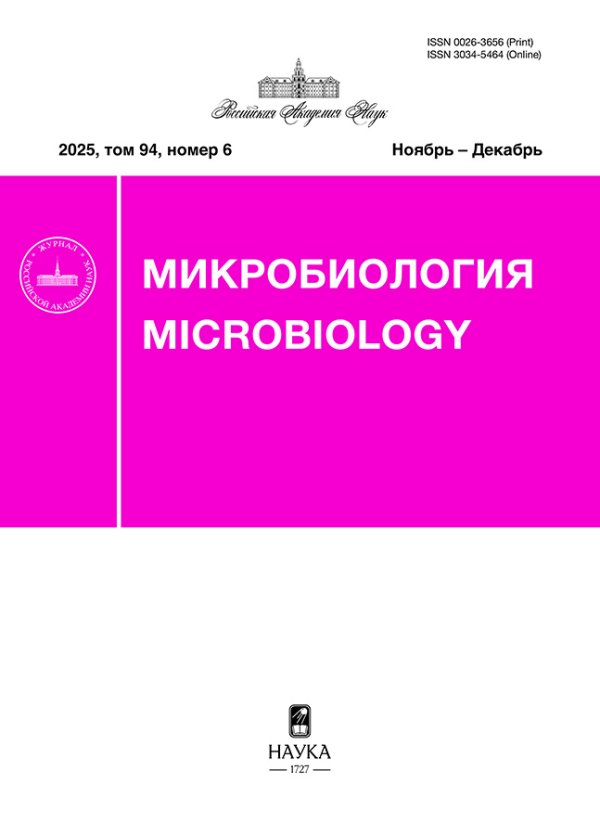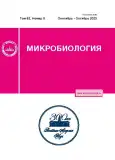High Efficiency of Removal of Pathogenic Microorganisms at Wastewater Treatment Plants in the City of Moscow
- Authors: Begmatov S.A.1, Dorofeev A.G.2, Pimenov N.V.2, Mardanov A.V.1, Ravin N.V.1
-
Affiliations:
- Institute of Bioengineering, Research Center of Biotechnology, Russian Academy of Sciences
- Winogradsky Institute of Microbiology, Research Center of Biotechnology, Russian Academy of Sciences
- Issue: Vol 92, No 5 (2023)
- Pages: 521-526
- Section: SHORT COMMUNICATIONS
- URL: https://journals.rcsi.science/0026-3656/article/view/140512
- DOI: https://doi.org/10.31857/S0026365623600153
- EDN: https://elibrary.ru/BHXILR
- ID: 140512
Cite item
Full Text
Abstract
Abstract—
While most pathogenic bacteria are efficiently removed from wastewater during biological treatment, some pathogens, notably Arcobacter, may be abundant in the purified water. Using 16S rRNA gene profiling, the composition of microbial communities of municipal wastewater in the city of Moscow was studied before and after biological purification at the Lyubertsy wastewater treatment plant. Fecal contaminants of the genera Acinetobacter, Aeromonas, Arcobacter, Bacteroides, Streptococcus, and Veillonella, which include human pathogens, predominated in the influent wastewater. After treatment, the relative abundance of these bacteria decreased by 50‒100 times. Predominant organisms in the microbiome of the effluent water were bacteria characteristic of activated sludge, including the nitrifiers of the genera Nitrospira and Nitrosomonas, as well as phosphate- and glycogen-accumulating microorganisms. Thus, pathogenic bacteria, including Arcobacter, are effectively removed at the Moscow wastewater treatment plant.
Keywords
About the authors
Sh. A. Begmatov
Institute of Bioengineering, Research Center of Biotechnology, Russian Academy of Sciences
Author for correspondence.
Email: shabegmatov@gmail.com
Russia, 119071, Moscow
A. G. Dorofeev
Winogradsky Institute of Microbiology, Research Center of Biotechnology, Russian Academy of Sciences
Email: shabegmatov@gmail.com
Russia, 119071, Moscow
N. V. Pimenov
Winogradsky Institute of Microbiology, Research Center of Biotechnology, Russian Academy of Sciences
Email: shabegmatov@gmail.com
Russia, 119071, Moscow
A. V. Mardanov
Institute of Bioengineering, Research Center of Biotechnology, Russian Academy of Sciences
Email: shabegmatov@gmail.com
Russia, 119071, Moscow
N. V. Ravin
Institute of Bioengineering, Research Center of Biotechnology, Russian Academy of Sciences
Email: shabegmatov@gmail.com
Russia, 119071, Moscow
References
- Загайнова А.В., Асланова М.М., Курбатова И.В., Ракова В.М., Федец З.Е., Пай Г.В., Грицюк О.В., Панькова М.Н., Новожилов К.А., Абрамов И.А., Иванова П.А., Недачин А.Е., Автономова А.А., Стародубова Н.Ю., Савостикова О.Н. Оптимизация методов санитарно-микробиологического и санитарно-паразитологического контроля сточных вод // Гигиена и санитария. 2022. Т. 101. С. 545‒555.
- Altwegg M., Geiss H.K. Aeromonas as a human pathogen // Crit. Rev. Microbiol. 1989. V. 16. P. 253‒286.
- Antunes L.C, Visca P., Towner K.J. Acinetobacter baumannii: evolution of a global pathogen // Pathog Dis. 2014. V. 71. P. 292‒301.
- Azcarate-Peril M.A., Roach J., Marsh A., Chey W.D., Sandborn W.J., Ritter A.J., Savaiano D.A., Klaenhammer T.R. A double-blind, 377-subject randomized study identifies Ruminococcus, Coprococcus, Christensenella, and Collinsella as long-term potential key players in the modulation of the gut microbiome of lactose intolerant individuals by galacto-oligosaccharides // Gut Microbes. 2021. V. 13. Art. 1957536. https://doi.org/10.1080/19490976.2021.1957536
- Begmatov S., Dorofeev A.G., Kadnikov V.V., Beletsky A.V., Pimenov N.V., Ravin N.V., Mardanov A.V. The structure of microbial communities of activated sludge of large-scale wastewater treatment plants in the city of Moscow // Sci. Rep. 2022. V. 12. Art. 3458. https://doi.org/10.1038/s41598-022-07132-4
- Collado L., Figueras M.J. Taxonomy, epidemiology, and clinical relevance of the genus Arcobacter // Clin. Microbiol. Rev. 2011. V. 24. P. 174‒192.
- Di Cesare A., De Carluccio M., Eckert E.M., Fontaneto D., Fiorentino A., Corno G., Prete P., Cucciniello R., Proto A., Rizzo L. Combination of flow cytometry and molecular analysis to monitor the effect of UVC/H2O2 vs UVC/H2O2/Cu-IDS processes on pathogens and antibiotic resistant genes in secondary wastewater effluents // Water. Res. 2020. V. 184. Art. 116194. https://doi.org/10.1016/j.watres.2020.116194
- Edgar R.C. Search and clustering orders of magnitude faster than BLAST // Bioinformatics. 2010. V. 26. P. 2460‒2461.
- Fisher J.C., Levican A., Figueras M.J., McLellan S.L. Population dynamics and ecology of Arcobacter in sewage // Front. Microbiol. 2014. V. 5. Art. 525. https://doi.org/10.3389/fmicb.2014.00525
- Frey B., Rime T., Phillips M., Stierli B., Hajdas I., Widmer F., Hartmann M. Microbial diversity in European alpine permafrost and active layers // FEMS Microbiol. Ecol. 2016. V. 92. Art. fiw018. https://doi.org/10.1093/femsec/fiw018
- Frigon D., Biswal. B.K., Mazza A., Masson L., Gehr R. Biological and physicochemical wastewater treatment processes reduce the prevalence of virulent Escherichia coli // Appl. Environ. Microbiol. 2013. V. 79. P. 835‒844.
- Hultman J., Tamminen M., Pärnänen K., Cairns J., Karkman A., Virta M. Host range of antibiotic resistance genes in wastewater treatment plant influent and effluent // FEMS Microbiol. Ecol. 2018. V. 94. Art. fiy038. https://doi.org/10.1093/femsec/fiy038
- Karaolia P., Vasileiadis S., Michael S., Karpouzas D., Fatta-Kassinos D. Shotgun metagenomics assessment of the resistome, mobilome, pathogen dynamics and their ecological control modes in full-scale urban wastewater treatment plants // J. Hazard. Mater. 2021. P. 418. Art.126387. https://doi.org/10.1016/j.jhazmat.2021.126387
- Koivunen J., Siitonen A., Heinonen-Tanski H. Elimination of enteric bacteria in biological-chemical wastewater treatment and tertiary filtration units // Water. Res. 2003. V. 37. P. 690‒698.
- Koskey A.M., Fisher J.C., Eren A.M., Ponce-Terashima R., Reis M.G., Blanton R.E., McLellan S.L. Blautia and Prevotella sequences distinguish human and animal fecal pollution in Brazil surface waters // Environ. Microbiol. Rep. 2014. V. 6. P. 696‒704. https://doi.org/10.1111/1758-2229.12189
- Kristensen J.M., Nierychlo M., Albertsen M., Nielsen P.H. Bacteria from the genus Arcobacter are abundant in effluent from wastewater treatment plants // Appl. Environ. Microbiol. 2020. V. 86. Art. e03044-19. https://doi.org/10.1128/AEM.03044-19
- Magoc T., Salzberg S. FLASH: Fast length adjustment of short reads to improve genome assemblies // Bioinformatics. 2011. V. 27. P. 2957‒2963.
- Mølgaard K., Nickelsen C., Jansen J. Hygienic quality of wastewater from municipal treatment plant. Report no. 684. Danish Environmental Protection Agency, Odense, Denmark. 2002. https://www2.mst.dk/udgiv/publikationer/ 2002/87-7972-078-1/pdf/87-7972-080-3.pdf
- Rognes T., Flouri T., Nichols B., Quince C., Mahé F. VSEARCH: a versatile open source tool for metagenomics // PeerJ. 2016. V. 4. https://doi.org/10.7717/peerj.2584
- Shchegolkova N.M., Krasnov G.S., Belova A.A., Dmitriev A.A., Kharitonov S.L., Klimina K.M., Melnikova N.V., Kudryavtseva A.V. Microbial community structure of activated sludge in treatment plants with different wastewater compositions // Front. Microbiol. 2016. P. 7. Art. 90. https://doi.org/10.3389/fmicb.2016.00090
- Wexler H.M. Bacteroides: the good, the bad, and the nitty-gritty // Clin. Microbiol. Rev. 2007. V. 20. P. 593‒621.
Supplementary files










